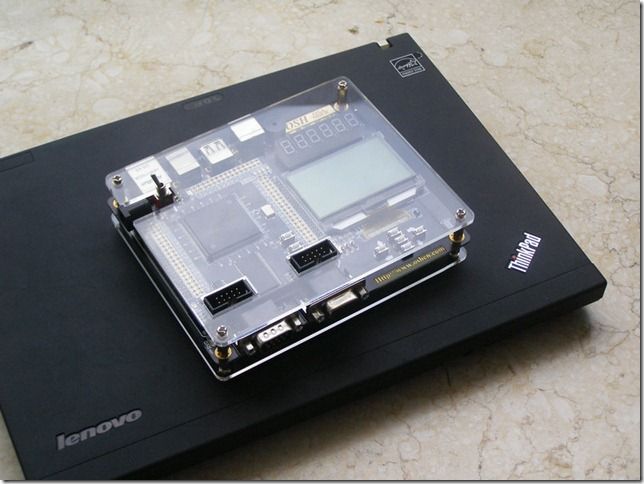本文转载至:http://www.cnblogs.com/Neddy/archive/2010/07/18/1780249.html,在此对原作者的辛勤劳作表示深深的敬意!
一、硬件(使用的是Quartus II 9.0)
1、建立工程,打开SOPC Builder,添加CPU
![]()
选择标准NIOS即可
2、添加PLL
![]()
点击Launch Altera‘s ALTPLL MegaWizard
![]()
器件速度等级按自己的FPGA选择,我的FPGA是EP2C8,所以选择8
输入时钟根据晶振决定,我的板子上是50MHz
输出两个时钟:
C0 50MHz 相位 0
C1 50MHz 相位 -72度
![]()
![]()
将Clock Settings中的pll.co更名为sys_clk,pll.c1更名为sd_clk
![]()
CPU的clock选择sys_clk
3、添加SDRAM(我板子上是K4S641632H)
Presets选择Custom
Data width选择16
![]()
4、添加JTAG_UART
![]()
5、添加PIO
width选择4,我的板子上只有四个LED
Direction选择Output port only
![]()
pio更名为led_pio
6、添加system ID
![]()
7、点击System—>Auto Assign Base address和Auto Assign IRQs,系统配置完毕
![]()
最后点击“Generate”生成系统
8、在Quartus II新建原理图BDF文件,添加刚建的SOPC
![]()
配置I/O后,运行Quartus,并在到目标板上……
二、软件(NIOS II 9.0)
~~~~~~~~~~~~~~~~~~~~~~~~~~~~~~~~~~~~~~~~~~~~~~~~~~~~~~~~~~~~~~~~~~~~~~~~~~~
/*
* led.h
*
* Created on: 2010-7-17
* Author: Administrator
*/
#ifndef LED_H_
#define LED_H_
void led(unsigned char dir)
{
unsigned char k,led;
unsigned int i,j;
for(k=10;k;k--)
{
for(i=0;i<4;i++)
{
if(!dir) led=1<
IOWR_ALTERA_AVALON_PIO_DATA(LED_PIO_BASE,~led);
j=0;
while(j<100000) j++;
}
}
}
#endif /* LED_H_ */
~~~~~~~~~~~~~~~~~~~~~~~~~~~~~~~~~~~~~~~~~~~~~~~~~~~~~~~~~~~~~~~~~~~~~~~~~~
#include
#include
#include "system.h"
#include "altera_avalon_pio_regs.h"
#include "alt_types.h"
#include "led.h"
int main()
{
FILE *fp;
char str[6];
char str1[5];
char str2;
fp=fopen("/dev/jtag_uart","r+");
if(fp)
{
while(strcmp(str1,"stop")!=0)
{
printf("Leds are ready,please input start or stop\n");
fgets(str,6,fp);
strcpy(str1,str);
str1[4]='\0';
if(strcmp(str,"start")==0) printf("Leds have run over,please input p or n or stop\n");
while(strcmp(str1,"stop")!=0)
{
str2=getc(fp);
if(str2=='n')
{
led(0);
printf("Leds have run over,please input p or n or s\n");
}
else if(str2=='p')
{
led(1);
printf("Leds have run over,please input p or n or s'\n");
}
else if(str2=='s') strcpy(str1,"stop");
}
}
}
printf("Leds have run over\n");
fclose(fp);
return 0;
}
~~~~~~~~~~~~~~~~~~~~~~~~~~~~~~~~~~~~~~~~~~~~~~~~~~~~~~~~~~~~~~~~~~~~~~~~~
运行
![]()
